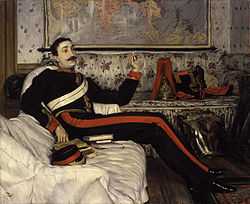Frederick Gustavus Burnaby

Colonel Frederick Gustavus Burnaby (3 March 1842 – 17 January 1885) was an English traveller and British Army officer.
Life

He was born in Bedford,[1] the son of the Rev. Gustavus Andrew Burnaby of Somerby Hall, Leicestershire, and canon of Middleham in Yorkshire (died 15 July 1872), by Harriet, sister of Henry Villebois of Marham House, Norfolk (d. 1883). His sister Mary married John Manners-Sutton. He was educated at Bedford School, Harrow, Oswestry School where he was a contemporary with William Archibald Spooner and legend has it could carry two boys under both arms up the stairs of school house, he was also educated in Germany.
He entered the Royal Horse Guards in 1859. Finding no chance for active service, his spirit of adventure sought outlets in balloon ascents and in travels through Spain and Russia. In the summer of 1874 he accompanied the Carlist forces in Spain as correspondent of The Times, but before the end of the war he was transferred to Africa to report on Gordon's expedition to the Sudan. This took Burnaby as far as Khartoum.[1]
Returning to England in March 1875, he matured his plans for a journey on horseback to the Khanate of Khiva through Russian Asia, which had just been closed to travellers. His accomplishment of this task, in the winter of 1875–1876, described in his book A Ride to Khiva, brought him immediate fame. His next leave of absence was spent in another adventurous journey on horseback, through Asia Minor, from Scutari to Erzerum, with the object of observing the Russian frontier, an account of which he afterwards published. In the Russo-Turkish War of 1877, Burnaby (who soon afterwards became lieutenant-colonel) acted as travelling agent to the Stafford House (Red Cross) Committee, but had to return to England before the campaign was over.[1]
In 1879 he married Elizabeth Hawkins-Whitshed, who had inherited her father's lands at Greystones, Ireland. The previously-named Hawkins-Whitshed estate at Greystones is known as The Burnaby to this day. At this point began his active interest in politics, and in 1880 he unsuccessfully contested Birmingham in the Tory-Democrat interest.[1]
In 1882 he crossed the English Channel in a hot air balloon. Having been disappointed in his hope of seeing active service in the Egyptian Campaign of 1882, he participated in the Suakin campaign of 1884 without official leave, and was wounded at El Teb when acting as an intelligence officer under General Valentine Baker. This did not deter him from a similar course when a fresh expedition started up the Nile. He was given a post by Lord Wolseley, and met his death in the hand-to-hand fighting of the Battle of Abu Klea.[1]
Henry Newbolt's poem "Vitaï Lampada" is often quoted as referring to Burnaby's death at Abu Klea; "The Gatling's jammed and the Colonel's dead...", (although it was a Gardner machine gun which jammed).[2] It was, perhaps, because of an impromptu order by Burnaby (who, as a supernumerary, had no official capacity in the battle) that the Dervishes managed to get inside the square. Although this seems unlikely considering the nature of the song 'Colonel Burnaby' which was written in his honour and the fact his portrait still hangs in the National Portrait Gallery, London.[3] The report carried in The Times, admittedly unlikely to be impartial considering his previous relations with the publication, tells of the colonel falling in the act of reforming a broken British square one of only two recorded cases of a British square breaking in the 19th century.
Works
- A Ride to Khiva: Travels and Adventures in Central Asia ISBN 978-0-19-288050-5
- On Horseback Through Asia Minor ISBN 978-0-19-282500-1
(both with an introduction by Peter Hopkirk)
- Practical Instruction of Staff Officers in Foreign Armies, published 1872
- A Ride across the Channel, published 1882
- Our Radicals: a tale of love and politics, published 1886
- Regular contributions to The Times, Vanity Fair and Punch from 1872 onwards
Legacy
A tall Portland stone obelisk in the churchyard of St Philip's Cathedral, Birmingham commemorates his life. Besides Burnaby's bust, in relief, it carries only the word "Burnaby", and the dated place names "Khiva 1875" and "Abu Klea 1885". The obelisk was unveiled by Lord Charles Beresford on 13 November 1885.[4]
There is a memorial window to Burnaby at St Peter's Church, Bedford.[5] There is also a public house, The Burnaby Arms, located in the Black Tom area of Bedford. The organ at Oswestry School Chapel was given in his memory.[6]
Notes
- ↑ 1.0 1.1 1.2 1.3 1.4 Chisholm 1911.
- ↑ "The Battle of Abu Klea of the Sudan Campaign 1885". Britishbattles.com. Retrieved January 2014.
- ↑ The life of Colonel Fred Burnaby by Chales.P.Corning
- ↑ Roger Ward, Monumental Soldier, in Hall, Brian (2001). Aspects of Birmingham. Wharncliffe Books. ISBN 1871647673.
- ↑ "Bedford digitisation people Burnaby Window". bedfordshire.gov.uk.
- ↑ Francis, Peter (2013). Shropshire War Memorials, Sites of Remembrance. YouCaxton Publications. p. 69. ISBN 978-1-909644-11-3.
References
-
 This article incorporates text from a publication now in the public domain: Chisholm, Hugh, ed. (1911). "Burnaby, Frederick Gustavus". Encyclopædia Britannica 4 (11th ed.). Cambridge University Press.
This article incorporates text from a publication now in the public domain: Chisholm, Hugh, ed. (1911). "Burnaby, Frederick Gustavus". Encyclopædia Britannica 4 (11th ed.). Cambridge University Press.
Further reading
| Wikimedia Commons has media related to Frederick Gustavus Burnaby. |
-
 John Andrew (1886). "Burnaby, Frederick Gustavus". In Stephen, Leslie. Dictionary of National Biography 7. London: Smith, Elder & Co. pp. 380–382.
John Andrew (1886). "Burnaby, Frederick Gustavus". In Stephen, Leslie. Dictionary of National Biography 7. London: Smith, Elder & Co. pp. 380–382.
- Olliff-Cooper, Jonty (17 January 2009). "Victorian celebrity". Prospect. Retrieved January 2014. — biography of a Frederick Burnaby
- "Bedfordshire Virtual Library – Frederick Gustavus Burnaby". bedfordshire.gov.uk.
|